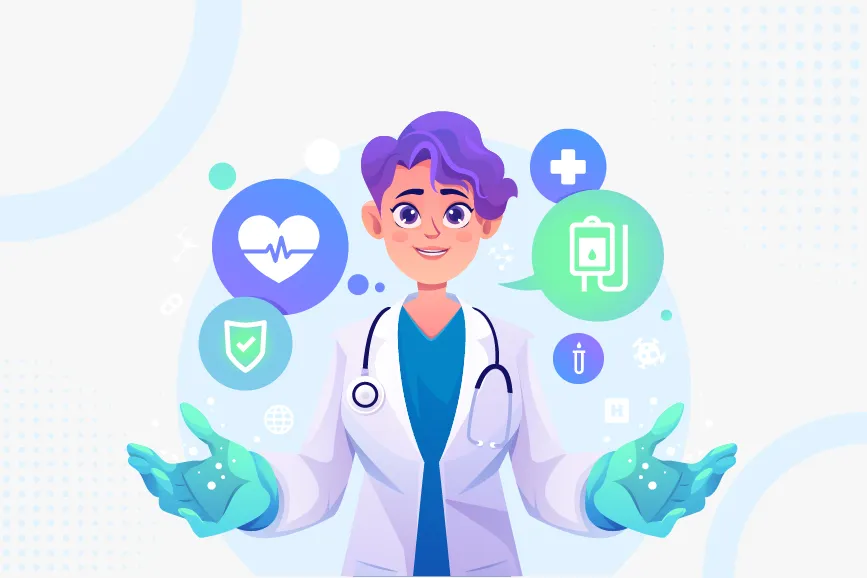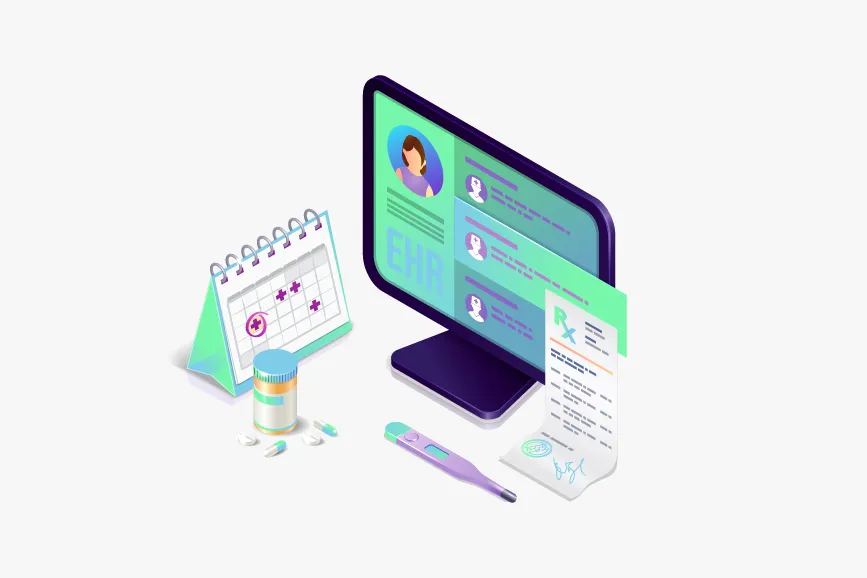In the early third millennium, extending the mobile experience to their clients has become a must-have for manufacturers and service providers across many domains – from banking and education to retail and transportation , because of the ubiquity of mobile gizmos, whose global number is currently twice as much as the total population of the planet.
The same is true for the healthcare industry, where creating software products rapidly turns into a lucrative niche capable of churning out solutions to cater to various needs of stakeholders in this sector.
While being generally on the rise lately, telemedicine app development received a powerful boost with the outbreak of COVID-19. As the worldwide scourge tightened its grip on humanity, we have come to rely critically on the remote mode in our working, shopping, studying, and entertainment routine, and telemedicine became a lifeline for people marooned in the safety of their pandemic-proof lodgings.
Telemedicine Explained
Telemedicine presupposes establishing an effective online link between doctors and patients who are located far away from each other.
Modern telemedicine development progresses as a part of a broader field of telehealth, or eHealth, where rendering medicare non-clinical services (training, education, administration) is also included. However, telemedicine carries the day among all of them.
Types of Telemedicine Apps
Being seasoned experts in healthcare software development , we at Owlab see that our customers conventionally commission apps that fall within four basic categories.

-
On-demand urgent care. This is the most popular application kind that arranges remote visits to the doctor. Such solutions rely on two-way audio and video call functionalities, sometimes including a text chat as well to let stakeholders interact in real-time. Besides, they require scheduling capabilities and access to electronic health records (EHR) databank.
-
Mental health. These apps aim to improve not the physical but psychological state of people ridden with depression and mental disorders through audio and video chat functionalities.
-
Planned care. This group has the same characteristics mentioned above, but they are enhanced with follow-up tools that enable conducting of routine examinations (store-and-forward capabilities) and tracking a patient's condition 24/7. In addition to physical examination, here the doctor makes extensive use of case history, images, and test results.
-
Self-care. Here belong apps that help people keep in good physical shape by monitoring their condition and giving qualified advice on training regime and diet. As a rule, solutions of this kind work in cooperation with wearables that track a person’s critical health metrics (pulse rate, blood pressure, walking distance covered, etc.).
Whatever type the telemedicine app belongs to, it should be developed with a view to the user audience. Depending on whether it is meant for patients or clinicians, it should contain a different roster of features.
Telemedicine App Features for Patients
What functionalities will provide a satisfying UX for patients?
-
Registration. Being a bread-and-butter feature for many apps, it should comply with data privacy regulations to make sure the patient's data won't be compromised. Besides, it should enable access to third-party platforms (like social networks) and the EHR system from which the owner must be able to upload documents.
-
Home page.Once the registration is accomplished, the user is directed to this screen, whence they should be able to navigate wherever they choose.
-
Patient’s profile The personal data that the patient enters here (residence, age, insurance policy number, images, etc.) should be synchronized with the hospital’s records to make appointment scheduling a breeze.
-
Medical records. People should be able to access the results of previous visits to the doctor or the patient’s whole medical history.
-
Search filters and doctor reviews. Patients should have all information about available doctors at their fingertips to select the one whose specialty, experience, qualification, and language are a perfect fit for them. Also, the opinions of other people who interacted with this doctor can be greatly instrumental in making a choice.
-
Scheduling. Once the physician is chosen, patients should see his/her timetable to pick the visiting hours at their convenience (to do that, calendar integration is a must). A notification of approval is then sent to the patient as soon as the clinician confirms it.
-
Interaction channels. As a rule, these include video calls as the staple and text messaging as an auxiliary to discuss some minor issues.
-
Notifications. They will keep the person aware of oncoming appointments, routine procedures, and visits, the necessity to renew the prescription, etc.
-
Payment gateways. Several options must be extended to people so that they can select the one they are comfortable with.
Telemedicine App Features for Doctors

Physicians can’t do without:
-
Doctor’s profile. It must contain not only all relevant data about the doctor (education, certification, experience, specialization, etc.) but also basic hospital workflow info, such as rating and shifts.
-
Appointment management. Panning workload is important for the doctor to optimize their daily routine.
-
EHR and data exchange. Without around-the-clock access to medical dossiers, a physician wouldn’t be able to provide high-end services to patients. Besides, the doctor should be able to draw upon the wisdom of other specialists, exchanging test results, X-ray images, recommendations, and more with their colleagues.
-
Communication tools. Since telemedicine is a two-way street, the doctor’s app needs such tools by default. Yet their version should be more advanced because they should be able to record visits to use them as evidence if a conflict occurs.
-
Prescription. In case the patient needs medications to combat the disease, the physician in their app must be able to do that, much as it happens during an offline session.
Once you know what type of telemedicine app you need, you should tackle its development hammer and tongs.
How to Develop a Telemedicine App: An Algorithm to Follow
Having successfully delivered a number of telemedicine app projects , our developers have come up with a roadmap we stick to while working on such solutions.
Step 1. Requirements analysis
Any project starts with taking a close look at the problem you are going to solve with the future product. When the business goal is defined, you should determine the scope of the project, its target audience, existing competition in the niche, the composition of the development team that will tackle it, and the tech stack it will wield. The latter includes the choice of the operating system (Android, iOS, or cross-platform ), programming languages, building tools, state-of-the-art know-how (IoT, AI, ML), etc.
Step 2. Feature list finalization
At this stage, you should come up with the final roster of features your app will contain, depending on the app type and requirements clarified during the previous phase.
Step 3. Estimating the cost
Developers calculate the total sum customers will have to fork out for the app. At this stage, this is only a ballpark number that can undergo some corrections if the client decides to upgrade the solution or, on the contrary, go lean on some functionalities.
Step 4. Development process
This one stage is going to take you the longest. First, you build the app’s backlog listing all functionalities, system logic, and product architecture. Then, following the backlog, you design the UI of your app (make sure it is user-friendly). After that, the backend coding kicks off, where you build the drafted features, implement integrations, and deal with dependencies. A recommended intermediate phase before the final version of the app is achieved is an MVP that will sound the user's interest and considerably curtail time-to-market.
Step 5. Testing
The telemedicine application development process isn’t over until you check how smoothly the product operates. If you enlist a high-profile QA team, it will run a whole range of tests (unit, stress, user acceptance, ADA, systems integrations, etc.) in manual and automatic mode on multiple devices to see whether the app functions as expected.
Step 6. Deployment
Now you can place the product in the app stores for users to enjoy it.
Step 7. Support and maintenance
Since both Android and iOS platforms release annual updates, it is vital not to leave your app out of sight and out of mind and upgrade your telemedicine application accordingly. An obliging software vendor that practices a user-first approach will extend such post-launch maintenance services to guarantee the most comfortable UX.
As you see, producing a top-notch telemedicine app is a no-nonsense job that should be entrusted to experts in the realm. Owlab has the necessary skills and experience to tackle a telemedicine project of any complexity and deliver a high-quality product at an affordable price.
Conclusion
eHealth is a robustly progressing field that is expected to manifest an astounding 10%+ CAGR within the next four years. The reasons for it are across-the-board digitalization advent and the influence of the global pandemic that spurred the introduction of the remote mode in numerous spheres. Given the pervasiveness of mobile gadgets, telemedicine apps as a kind of eHealth software are going to reign supreme in the niche. Once you fill it with features relevant to the user audience and make sure it functions seamlessly, the stream of revenues into your company’s coffers will not be late in coming.